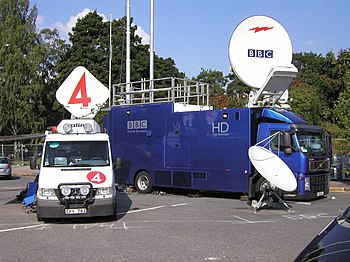Satellite truck
These remote ISP services are used for disaster recovery and internet connectivity in areas underserved by mobile providers.
Some newer generation satellite trucks are also being used for crisis communications, along with command and control centers for law enforcement, homeland security, emergency managers, and public utility companies.
The fact that these trucks do not rely upon terrestrial (land-based signals received through a conventional aerial) communication systems makes them ideal for information distribution and bandwidth creation in the aftermath of severe tropical cyclones, floods, and earthquakes when these land-based systems are damaged or destroyed.
Prior to dispatch of a C Band transportable uplink, an RF Interference study (RFI) needs to be completed.
This was expensive and difficult to do at the time, since telephone companies were not used to setting up phone lines without notice of several days or even weeks.
C-Band transportable service remains a prevalent source of long-haul transmission because of its immunity to the "rain fade" that Ku band experiences in significant rainstorms.
It's still used in situations where rain-fades (a problem affecting only Ku band uplinks) are unacceptable and where fiber-optic links are not practical.
C-Band uplinks are still commonly used for golf, auto racing, horse racing, and major college sports events in rural areas where local fiber interconnects to long-haul networks are either not available, or where the low number of events at the venue per year makes installation of fiber not cost effective.
In the 2000's, high-definition television (HDTV) remote broadcasts caused a resurgence in C-Band transportable uplink services.
The major factor in its resurgence was the limited amount of available bandwidth in local and long-haul fiber-optic service; uplink systems merely required the installation of High Definition MPEG digital encoders and decoders at either end.
Along with the truck, and used vans later purchased from Telesat in Canada, Conus developed a communications system which allowed satellite transmissions without the need to drop phone lines.
The development of the mobile phone and its decreasing cost of operation and hardware over the years means trucks don't need a satellite "comms" system in most places.
Satellite time was also easily booked on an 'as-needed' basis, typically around $500 per hour for the common Ku band TV transmission.
Such large uplink trucks now have multiple camera television production capabilities all on board, as pioneered by Satellite Digital Teleproductions (SDTV) in the early 1990s.
Having a background in auto mechanics can also help, especially considering that many truck's main power source is a diesel generator.
Satellite truck operators are often not as interchangeable as reporters, producers, or camera crews, and as a result, can be worked full news cycles (e.g. morning to night).

